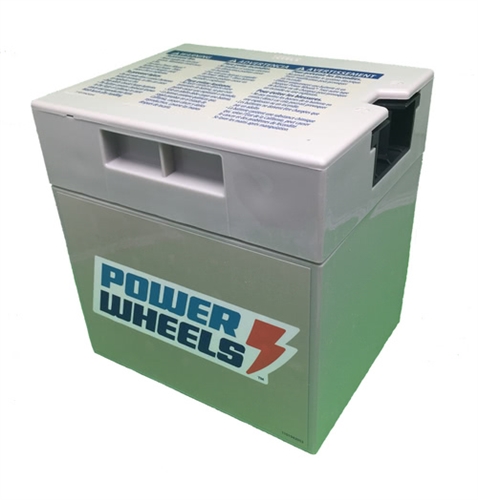-
Free Shipping
Orders $75 & Up
-
30-day Money Back
Guarantee*
-
100% Secure Online Shopping
SSL - Verified Merchant

Power Wheels 12 v Grey Battery: 00801-0638
$68.95
12-Volt Fisher Price Power Wheels Battery 00801-0638
What to Expect from the Power Wheels Replacement Battery
This Power Wheels 12v 00801-0638 battery has been designed to fulfill rigorous Power Wheels requirements in order to provide the best possible performance, durability and maximum play time for Power Wheels® vehicles.
Uses & Compatibility
Power Wheels Battery 00801-0638 can be used with:
- Fisher-Price® Power Wheels® Advanced Series vehicles
- Type 12V battery system only
It is a compatible replacement for battery models:
- 00801-1048
- 00801-1460
- 00801-1869
- 00801-0638
Product Features
- Sealed Maintenance Free Design
- OEM Battery
- 1-Year Warranty
- Designed with Internal Fuse
Specs & Performance
- Voltage: 12
- Capacity: 9.5 amp hours
- Terminal: Insert
- Length: 4.25"
- Width: 5.50"
- Height: 5.25"
- Weight: 10.1 lbs
Warranty & Replacement
High-Tech Battery Solutions carries the OEM Power Wheels Battery for Fisher Price power wheels in stock and ready for shipment. This battery is guaranteed to meet or exceed the OEM specifications established by Fisher Price.
Frequently Purchased Together:
Contact Us
Do you have a question? You can contact us online or toll free at 1-877-775-4381 to talk to a battery specialist today.
Demo Video
This is an original OEM battery manufactured for Fischer Price Power Wheels® vehicles with 12v systems or utilizing the Grey 12 Volt Battery.The following Power Wheels® toys are compatible with this replacement battery:
| Power Wheels Model Name | Model # | Power Wheels Model Name | Model # |
| Power Wheels Eliminator | 73180-9993 | Barbie Cadillac Escalade | J5246 |
| Power Wheels Harley Davidson | 73210-9997 | Power Wheels Kawasaki Brute Force | J5248 |
| Power Wheels Harley Davidson | 73218-9993 | Power Wheels Kawasaki Kfx Ninja | J8472 |
| Power Wheels Lightning | 73530-9993 | Power Wheels Mustang | J9561 |
| Power Wheels Minibike | 73535-9993 | Power Wheels Mustang | J9562 |
| Power Wheels Super Shock | 73600-9997 | Power Wheels Kawasaki Kfx Ninja | K0450 |
| Power Wheels Super Shock | 73600-9993 | Power Wheels Dora Jeep Wrangler | K4563 |
| Power Wheels Ninja | 73690-9993 | Power Wheels Ford F150 | K8285 |
| Power Wheels Jeep Wrangler | 74020-9993 | Power Wheels Diego Jeep Wrangler | K9758 |
| Power Wheels Police Harley | 74287-9993 | Power Wheels Arctic Cat | L2170 |
| Power Wheels Chevy Truck | 74310-9993 | Power Wheels Nascar Dale Earnhardt Jr | L6345 |
| Power Wheels Barbie Cruisin Tunes | 74340-9993 | Power Wheels Ford F150 | L6348 |
| Power Wheels Barbie Harley | 74370-9993 | Power Wheels Barbie Mustang | L6349 |
| Power Wheels Jeep Sandblaster - Sam | 74526-9993 | Power Wheels Barbie Jammin Jeep | L7820 |
| Power Wheels Trail Beast | 74527-9993 | Power Wheels Nascar Jimmie Johnson | L7821 |
| Power Wheels Sawblade | 75597-9993 | Power Wheels Nascar Jeff Gordon | L7822 |
| Power Wheels Limited Edition Jeep Wrangler | 75598-9993 | Power Wheels Nascar Tony Stewart | L7823 |
| Power Wheels Copper Wrangler 2001 | 75840-9993 | Power Wheels Cadillac Escalade Refresh | L7824 |
| Power Wheels Cruisin Tunes Restage | 77770-9993 | Power Wheels Arctic Cat Camo | L7825 |
| Power Wheels Jeep Wrangler 2000 | 78537-9993 | Power Wheels Cadillac Escalade Barbie | M0409 |
| Power Wheels Fire Rescue Jeep | B0155-9993 | Power Wheels Cadillac Escalade | M0410 |
| Power Wheels Chevy Silverado | B1476-9997 | Power Wheels Harley Cruiser | M0412 |
| Power Wheels Chevy Silverado | B1476-9993 | Power Wheels At Rex | M7873 |
| Power Wheels Barbie Beach Ranger | B1675-9993 | Power Wheels Ford F150 Craftsman | M9779 |
| Power Wheels Bb Ranger Tru 03 | B2489- | Power Wheels Escalade Hybrid | M9780 |
| Power Wheels Harley Davidson | B3160 | Power Wheels At Rex | N0457 |
| Power Wheels Barbie Dune Beetle 12v | B3162 | Power Wheels Barbie Escalade | N1475 |
| Power Wheels Jeep Wrangler Restage | B7659 | Power Wheels Jeep Rubicon | N1476 |
| Power Wheels Max Steel Ninja | B8551 | Power Wheels Escalade | N8417 |
| Power Wheels Kawasaki Kfx | B9272 | Power Wheels Kawasaki Brute Force | N9731 |
| Power Wheels Girl's Harley Restage | B9784 | Power Wheels Stinger | P4266 |
| Power Kawasaki Adventure 4x4 W/ Trailer | B9785 | Power Wheels Barbie Kfx | P5066 |
| Power Wheels Rally Kart | C0530 | Power Wheels Boys Mustang - Restage | P5920 |
| Power Wheels Racer Kart | C0532 | Power Wheels Girls Mustang | P6827 |
| Power Wheels Jeep Wrangler | C2390 | Power Wheels Barbie Mustang | P8812 |
| Power Wheels Kawasaki | C7478 | Power Wheels Arctic Cat Red | P8814 |
| Power Wheels Street Scene Silverado | G3740 | Power Wheels Red Kfx | P9723 |
| Power Wheels City Slammin' Silverado | H0128 | Power Wheels Brute Force | R8126 |
| Power Wheels Volkswagen Dune Beetle | H0150 | Power Wheels Kawasaki Brute Force | R8548 |
| Power Wheels Gravedigger | H0436 | Power Wheels Barbie Jammin Jeep | T4871 |
| Power Wheels Cadillac Escalade | H0438 | Power Wheels Target Red | T4872 |
| Power Wheels Cadillac Escalade | H0440 | Power Wheels Dora Jeep Wrangler | T6137 |
| Power Wheels Classic Chrome Harley | H0638 | Power Wheels Tough Talking Jeep | T6138 |
| Power Wheels Driveway Racer | H2836 | Power Wheels Ford F150 | T6991 |
| Power Wheels Barbie Jammin' Jeep | H3427 | Power Wheels Barbie Jammin | T8396 |
| Power Wheels Barbie Beach Party Jeep Wrangler | H4433 | Power Wheels Ford F150 | W0029 |
| Power Wheels Barbie Beach Party Jeep Wrangler | H4433 | Power Wheels Ford F150 | W0030 |
| Power Wheels Blue Jeep Wrangler | H4803 | Power Wheels Ford F150 Raptor | W1070 |
| Power Wheels Jeep Wrangler | H4805 | Power Wheels Barbie Jammin Jeep W/ Bounus Barbie | W1652 |
| Power Wheels Jeep Wrangler | H4807 | Power Wheels Dune Racer | W2602 |
| Power Wheels Jeep Wrangler | H9170 | Power Wheels Barbie Jammin Jeep | W4473 |
| Power Wheels Classic Chrome Harley | H4808 | Power Wheels Hot Wheels Kfx | W4716 |
| Power Wheels Dora Quad | H7332-9993 | Power Wheels Dune Racer Pink Color | Y6533 |
| Power Wheels Lightning Mcqueen | H8256-9991 | ||
| Power Wheels Kawasaki Kfx Ninja Extreme | H9800 | ||
| Power Wheels Mustang | J4390 |








